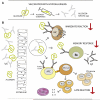Mechanisms underlying allergy vaccination with recombinant hypoallergenic allergen derivatives
- PMID: 22100888
- PMCID: PMC4571077
- DOI: 10.1016/j.vaccine.2011.11.011
Mechanisms underlying allergy vaccination with recombinant hypoallergenic allergen derivatives
Abstract
Hundred years ago therapeutic vaccination with allergen-containing extracts has been introduced as a clinically effective, disease-modifying, allergen-specific and long-lasting form of therapy for allergy, a hypersensitivity disease affecting more than 25% of the population. Today, the structures of most of the disease-causing allergens have been elucidated and recombinant hypoallergenic allergen derivatives with reduced allergenic activity have been engineered to reduce side effects during allergen-specific immunotherapy (SIT). These recombinant hypoallergens have been characterized in vitro, in experimental animal models and in clinical trials in allergic patients. This review provides a summary of the molecular, immunological and preclinical evaluation criteria applied for this new generation of allergy vaccines. Furthermore, we summarize the mechanisms underlying SIT with recombinant hypoallergens which are thought to be responsible for their therapeutic effect.
Copyright © 2011 Elsevier Ltd. All rights reserved.
Figures

Similar articles
-
Developments in allergen-specific immunotherapy: from allergen extracts to allergy vaccines bypassing allergen-specific immunoglobulin E and T cell reactivity.Clin Exp Allergy. 2010 Mar;40(3):385-97. doi: 10.1111/j.1365-2222.2009.03443.x. Clin Exp Allergy. 2010. PMID: 20210812
-
Recombinant allergens: the present and the future.Hum Vaccin Immunother. 2012 Oct;8(10):1534-43. doi: 10.4161/hv.22064. Epub 2012 Oct 1. Hum Vaccin Immunother. 2012. PMID: 23095874 Free PMC article. Review.
-
Preventive Allergen-Specific Vaccination Against Allergy: Mission Possible?Front Immunol. 2020 Jul 7;11:1368. doi: 10.3389/fimmu.2020.01368. eCollection 2020. Front Immunol. 2020. PMID: 32733455 Free PMC article. Review.
-
Allergen-specific immunotherapy: from therapeutic vaccines to prophylactic approaches.J Intern Med. 2012 Aug;272(2):144-57. doi: 10.1111/j.1365-2796.2012.02556.x. J Intern Med. 2012. PMID: 22640224 Free PMC article. Review.
-
Recombinant allergy vaccines based on allergen-derived B cell epitopes.Immunol Lett. 2017 Sep;189:19-26. doi: 10.1016/j.imlet.2017.04.015. Epub 2017 May 1. Immunol Lett. 2017. PMID: 28472641 Free PMC article. Review.
Cited by
-
A folded and immunogenic IgE-hyporeactive variant of the major allergen Phl p 1 produced in Escherichia coli.BMC Biotechnol. 2015 Jun 9;15:52. doi: 10.1186/s12896-015-0150-z. BMC Biotechnol. 2015. PMID: 26054338 Free PMC article.
-
The Effector Function of Allergens.Front Allergy. 2022 Feb 7;3:818732. doi: 10.3389/falgy.2022.818732. eCollection 2022. Front Allergy. 2022. PMID: 35386644 Free PMC article. Review.
-
Vaccines for allergy.Curr Opin Immunol. 2012 Jun;24(3):354-60. doi: 10.1016/j.coi.2012.03.006. Epub 2012 Apr 20. Curr Opin Immunol. 2012. PMID: 22521141 Free PMC article. Review.
-
Safety of engineered allergen-specific immunotherapy vaccines.Curr Opin Allergy Clin Immunol. 2012 Oct;12(5):555-63. doi: 10.1097/ACI.0b013e328357ca53. Curr Opin Allergy Clin Immunol. 2012. PMID: 22885888 Free PMC article. Review.
-
Multiple grass mixes as opposed to single grasses for allergen immunotherapy in allergic rhinitis.Clin Exp Allergy. 2013 Nov;43(11):1202-16. doi: 10.1111/cea.12128. Clin Exp Allergy. 2013. PMID: 24152153 Free PMC article. Review.
References
-
- Floistrup H, Swartz J, Bergstrom A, Alm JS, Scheynius A, van Hage M, et al. The Parsifal Study. Allergic disease and sensitization in Steiner school children. J Allergy Clin Immunol. 2006;117:59–66. - PubMed
-
- Kay AB. Allergy and allergic diseases. Blackwell Science; Oxford: 2008.
-
- Noon L. Prophylactic inoculation against hay fever. Lancet. 1911;1:1572–3.
-
- Bousquet J, Lockey R, Malling HJ. Allergen immunotherapy: therapeutic vaccines for allergic diseases. A WHO position paper. J Allergy Clin Immunol. 1998;102:558–62. - PubMed
Publication types
MeSH terms
Substances
Grants and funding
LinkOut - more resources
Full Text Sources
Other Literature Sources
Medical

